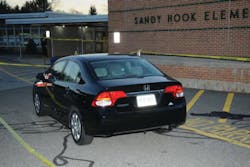Sandy Hook one year later: How much longer do our schools have to wait?
Editor’s note: There’s still time to register for our upcoming webinar this Thursday at 1 p.m. ET on Lessons Learned from Sandy Hook. Our panel of experts will discuss what school security professionals should take away from the tragedy that can help them better secure their own facilities.
A year has passed and it’s clear that the tragic events at Sandy Hook Elementary School that left 26 people dead – most of them young children – were still not enough to move us, as a nation, toward implementing comprehensive solutions to truly secure our 55 million K-12 students in more than 130,000 schools.
Instead, we turned another disaster into a political game with our leaders trying to score points with a numbed public. Amid all the rhetoric, we lost focus and now seem willing to sit complacently until the next Sandy Hook happens. And it will. And we’ll likely react the same way. Remember Columbine? Red Lake? Nickel Mines?
In the aftermath of Sandy Hook, the media bombarded us with so-called experts. Were lax gun control laws the problem or were we not spending enough on mental healthcare? The answer to that question is yes and yes. But the debate shouldn’t revolve around the Second Amendment or building more mental health facilities. Anything coming from those debates represents longer-term fixes. What we need is a serious discussion about the proven solutions that will work today.
Not surprisingly, the National Rifle Association suggested putting thousands more lethal weapons on school campuses by arming lightly trained teachers to act as a barrier against a heavily armed shooter.
The federal government offered no real leadership. Plus, over the past few years, we’ve seen valuable federal programs offering schools grants for security improvements either gutted or entirely eliminated. To their credit, a few states did step up and made available additional funding for security projects. However, most did nothing significant.
And school officials were left wondering what to do. The job of preventing the next Sandy Hook shouldn’t be left to educators. It’s time that we build a national consensus to solve this problem. It’s time that our elected and appointed leaders stand up and lead. It’s time that we stop with these hand-wringing anniversaries and do something, but what?
National Standards
I advocate a plan I call PTP2,which stands for planning, technology, and people and preparation. Let’s start with the federal government setting minimal PTP2 standards for every school campus in every state. Here’s a look at what those standards should include.
Planning – The planning process begins with every school undergoing a thorough risk assessment completed by an experienced and impartial outside provider. That assessment needs to start in the parking lot and work into the classrooms. An assessment will identify each campus’ security strengths and weaknesses. It will review and update policies and procedures for handling an active shooter. It will suggest potential improvements in landscaping, lighting, fencing, signage, security screens and other inexpensive, low-tech solutions.
Technology – Electronic equipment can add extra layers of campus security. Begin with hardening the school entry. If you can walk unchallenged onto your local school campus, it’s unsafe. Historically, shooters have entered schools through the front door. Allow only one public entry. Use signage to direct a visitor to a video intercom, where a school receptionist can see and talk with the person before remotely unlocking the door. Inside the office, lock the passage to classrooms and other parts of the campus until the visitor produces a government-issued photo ID for a visitor management system to check against federal and state databases for known felons and sex offenders. That system can also include local information about fired district employees and expelled students. Require the visitor to wear a temporary ID badge at all times while on campus.
Harden the classroom by installing locks that automatically lock doors when closed. This requires no action by teachers to lock the door during an emergency. If the doors are solid, add peepholes to allow the teacher to verify the identity of anyone wanting access.
Place panic buttons in the office, cafeteria, library and other locations throughout the campus where faculty and staff can immediately access first responders in an emergency situation.
Monitor the entire campus with surveillance cameras. These have been proven to be a strong deterrent, as well as vital in reviewing incidents after they occur. They also provide critical, live insight for first responders during an emergency situation.
People and Preparation – Even the best emergency plan is worthless if people don’t know how to use it. Practice an active shooter drill so often that every administrator, teacher and staff member instinctively knows how to react when an emergency strikes. Also, develop a close relationship with local first responders. Provide them with campus maps, as well as landline and mobile phone numbers for key school contacts.
Also, every school plan should include a provision for an armed and well-trained police officer on campus during school hours. If a school resource officer cannot be assigned, work with local law enforcement to make sure officers can respond within minutes. Helping to gain support and funding for this idea would be a perfect project for the NRA to promote.
One more thing, we need to restore and augment federal grants and encourage states, cities and private organizations to make more money available to pay for campus security enhancements. Only then can we can begin to hold superintendents and school boards accountable.
It CAN Happen Here
Fortunately, schools are generally a safe place for students. But it’s that sense of “it can’t happen here” that lulls us into accepting the status quo. A look at the shootings over the past 15 years shows they happen on campuses large and small. They have taken place in cities, suburbs and rural areas. Gunmen kill on affluent and poor campuses. There is no way of predicting where the next tragedy will occur.
Many people argue that it’s difficult to protect children from heavily armed, mentally disturbed people prepared to give their lives. Yes, it is difficult, but not impossible. And we can do this without making our schools resemble prisons.
Accomplishing this will require political leadership. It will require advocacy groups to temporarily shelf their unyielding agendas. It will require school board members and district superintendents to give security a priority along with academics. It will require parents and other voters making it clear they will no longer accept excuses or inaction.
As a nation, we’ve often shown ourselves capable of putting aside disagreements, overcoming apathy and finding the resources to solve serious problems. We can protect our children. They deserve nothing less.
The clock is ticking. We don’t have time to delay.
About the Author: Patrick V. Fiel, Sr. is an independent security consultant currently advising Security Identification Systems Corp. (SISCO), maker of the FAST-PASS visitor management system. Fiel also has served as public safety advisor for a large national security integrator; executive director of security for the Washington, D.C. Public School System; and is retired from the U.S. Army Military Police Corps.
About the Author

Patrick V. Fiel, Sr.
Former Executive Director of Security for Washington, D.C. Public Schools
Patrick V. Fiel Sr., a national security expert with more than 40 years of experience in law enforcement and security management, is a retired member of the U.S. Army Military Police Corps. He is available to speak on risk assessments, active shooter preparedness and security best practices. He can be reached at (910) 789-4265 or [email protected].
